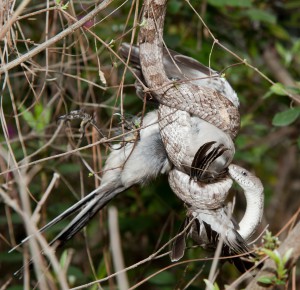Most people, including myself, have been taught this. Snakes are in an unusual situation of trying to kill prey with no hands or claws. A few can inject venom, others either swallow it whole (such as an egg) or the coil around their prey “suffocating” it – or so we thought. It has been my understanding that snakes did not actually “squeeze” the air out of their prey but rather coil tighter each time the prey exhales, tighten the coils until the prey is dead due to lack of oxygen. A recent paper published in the Journal of Experimental Biology is challenging this.
The issue stems around the fact of how fast the prey die. Some biologists felt death of the prey occurred to quickly for suffocation; thus began the hunt of what was the cause. Dr. Scott Boback, of Dickinson College in Pennsylvania, looked at the possibility of cardiac arrest. He and his team developed a method of monitoring cardiac and circulatory data in rats before, during, and after an attack by a constricting snake; in this study – the common boa. Using pre-attack vitals as baseline the team compared numbers during the attack and after death; which occurred, on average, 6.5 minutes. What they found was interesting.
Within six seconds of being bitten and having the body coil the peripheral arterial blood pressure dropped by half and the central venous blood pressure increased six fold. After 60 seconds the heart rate had dropped by 50%. After death, again mean time was 6.5 minutes, the peripheral arterial blood pressure and heart rate had dropped significantly and 91% of the rats (n=11) had evidence of a dysfunctional cardiac system. Blood samples were taken from the deceased rats. These samples indicated that the potassium levels had increased 2-fold and the pH and dropped from 7.4 to 7.0. Some suggest that the increased potassium levels may have been toxic enough to kill the rat.
Though this is only one study the results do suggest that the cause of death may be due to cardiac arrest and not the lack of oxygen. For many of us it is a point of “who cares… the rat is dead”. But for those of us in science education (teachers, park rangers, etc.) the results are of interest. We are being asked to explain how the scientific process works to students, visitors to parks, and to the general public. This is a good example of how science works. The process of experimentation finding results that do not always fit the “norm” of general understanding yet they do occur, generating more questions and more experimentation. Though this one study does not mean that suffocation is incorrect it does suggest there is another explanation and this, at least at this stage, is how we should explain such things to the public.
To view a copy of the article and abstract for this paper visit:
http://jeb.biologists.org/content/218/14/2279.abstract
- Marine Creatures of the Northern Gulf of Mexico – Amoeboid Protozoans - December 20, 2024
- Marine Creatures of the Northern Gulf of Mexico – Flagellated Protozoans - November 22, 2024
- Marine Creatures of the Northern Gulf of Mexico – Dinoflagellates - November 15, 2024

